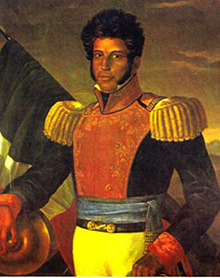
|
 |
 |
 Editorials | Issues | February 2008 Editorials | Issues | February 2008  
Black President? Mexico Has Been There, Done That ... in 1829
 Rose Ybarra - The Enterprise Rose Ybarra - The Enterprise
go to original


| | Vicente Ramon Guerrero, the second president of Mexico | | |
If Barack Obama wins the presidential election, he will be the first black president in U.S. history - but he wouldn't be the first black president in North America.

That honor belongs to Vicente Ramon Guerrero, the second president of Mexico and one of the most fascinating figures in Mexican history.

Guerrero, who was of white, black and Indian descent, took office in 1829.

"Many people are unaware than Mexico had a black president," said Ray Von Robertson, a sociology professor at Lamar University in Beaumont.

"It's not the kind of information you'll find in a textbook, but it should be. It is information that black people need to know. He is a very significant part of African and African-American history."

African-American historian J.A. Rogers and author of the 1947 book, "World's Great Men of Color," described Guerrero as the George Washington and Abraham Lincoln of Mexico because he played a pivotal role in Mexico's independence from Spain.

He fought on the front lines and recruited new soldiers, mostly Indians, to the cause. He was elevated to the rank of captain just one year after joining the fight.

More than a century before hanging chads dominated the headlines in the 2000 presidential election in the United States, the Mexican congress declared Guerrero the winner after the outcome of the election was challenged.

During his eight-month tenure as president, Guerrero abolished slavery in Mexico - more than 30 years before slavery was abolished in the United States.

Guerrero, who was born into a peasant family, also disabled Mexico's long-standing caste system, said Carlos Muñoz, Jr., professor emeritus in the Department of Ethnic Studies at the University of California at Berkeley.

"Mexico suffered a profound, tremendous caste system during its colonial period, but Guerrero somehow was successful in tearing it down," Muñoz said.

He also declared that all inhabitants, whether white, African or Indian, were qualified to hold office under the Mexican constitution.

Though Guerrero was wildly popular with the masses, the middle and lower classes, the rich were less fond of him.

He was ousted from office Dec. 16, 1829, in a revolt orchestrated by his vice president, Anastasio Bustamante.

Guerrero initiated a counter-revolution after leaving office but was unsuccessful in reclaiming the presidency.

Francisco Pucaluga, a close friend, was paid to betray Guerrero by luring him to a dinner party.

When Guerrero arrived for the soirée, he was abducted, held prisoner and ultimately killed.

When word spread of his death, there was nationwide revolt and Pucaluga was killed in retaliation.

A Mexican state on the Pacific coast is named in honor of Guerrero. It is home to several resort towns, including Acapulco.

Muñoz said it took Mexican historians and anthropologists more than 100 years to acknowledge Guerrero's African roots and even longer for that information to trickle into classrooms and books.

"Before then, the myth that all Mexicans are mestizos - or a mix of indigenous and Spanish - was being perpetuated," Munoz said. "It's finally coming to light that Mexicans also have African roots, Middle Eastern roots and even Asian roots."

Robertson said he's been talking about Guerrero in his classes for years and his students usually are skeptical when he mentions that Guerrero was black.

"Sometimes, they don't believe me," Robertson said. "I've had to print out information from the Internet so they can see it."

Robertson also tells his students about system similar to the Underground Railroad that American slaves in the South utilized as a means to escape to Mexico.

"Not all slaves fled north," he said. "Many of them also headed south to Mexico. There were a lot of black settlements in northern Mexico."

Muñoz said in recent years, African and African-American studies scholars from the United States have reached out to historians in Mexico.

"They have found a common history and they are forging relationships," he said. | 
 | |
 |



